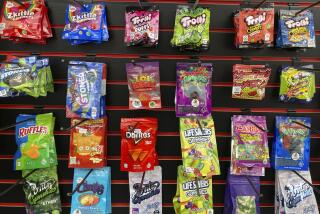Drug Abuse More Common Among Dropouts, Study Finds : Youth: Teen-agers who quit school also report much higher rates of criminal activity. Findings highlight need for intervention at an earlier age, officials say.
- Share via
Shedding light on the web of troubles that ensnare youths who quit school, a new statewide survey shows that teen-age dropouts abuse drugs and alcohol and engage in criminal activities at dramatically higher rates than students who stay in school.
Dropouts were three times more likely to use methamphetamines, five times more likely to use cocaine or crack, and twice as likely to use LSD than their in-school counterparts.
They reported weekly alcohol use rates twice as high as that of students--with beer the leading intoxicant--and were more likely to drive while drunk.
Dropouts also ranked higher than students on a wide range of other problem behaviors, such as involvement in fights, selling or dealing drugs and committing a crime to obtain drugs.
“We hope people will focus on how serious the dropout problem is and what the ramifications are,” said state Supt. of Public Instruction Delaine Eastin.
“We see lives more troubled by violence and personal problems; youngsters using alcohol, tobacco and other drugs at earlier ages and higher rates, and huge losses of human potential.”
Although the statewide dropout rate has not grown over the last three years, it remains an enormous problem, with about 70,000 youths a year failing to complete high school.
The survey was released Monday at a Sacramento news conference hosted jointly by Eastin, Atty. Gen. Dan Lungren and Andrew Mecca, director of the state Department of Alcohol and Drug Programs.
The officials said the $156,000 study, conducted by Southwest Regional Laboratory, is the first California study to compare dropouts and students in their use of drugs and alcohol.
Previous studies of teen-agers’ drug and alcohol use had only examined students, leaving state officials to guess about the extent of the abusive behaviors among dropouts. “Now we know accurately what the problem is,” Mecca said.
Eastin said she hoped the study would focus attention on the importance of identifying youths at risk of school failure as early in their school years as possible.
The findings, she said, “point to the need for much stronger alcohol and drug prevention in elementary and middle school. High school clearly is too late.”
State officials said it was not clear from the survey whether drug and alcohol use causes students to drop out or whether dropping out leads to drug and alcohol use.
The dropouts said the chief reason they left school was because they disliked it or were bored (22.9%). Only a small number (7.7%) volunteered that they left because of problems with drugs or alcohol.
Stewart Donaldson, an associate professor of preventive medicine at USC, said many other studies have shown that alcohol and drug use among teen-agers leads to a variety of behavioral problems, including dropping out of school.
Donaldson, who was not involved in the state survey but is an expert on drug abuse prevention strategies, said the study confirms other findings that dropouts are highly susceptible to a wide range of troubling behavior.
The survey results were based on responses from 1,243 dropouts from 20 communities statewide. Respondents’ average age was 16 and the sample was predominantly black and Latino, fitting the profile of dropouts statewide.
Dropouts were defined as youths who had missed school for 45 consecutive days without an excuse or notifying the school.
The comparison group of students was drawn from a 1993-94 survey of alcohol and drug use among California students conducted biennially by the state.
Lungren said the survey pinpoints the “twin troubles” of dropping out and using drugs. Dropouts tended to be more involved in criminal and violent activity, according to the survey.
Thirty-three percent of the dropouts surveyed said they had sold drugs in the past year, compared to 17.7% of students. Fifteen percent said they had been arrested on drug-related offenses, while 20% said they had committed a crime in order to obtain drugs.
Twice as many dropouts as students said they had belonged to a gang at some time (34.6% versus 15.6%). Fifty-five percent of dropouts said they had been in a fight recently, compared to 32% of students. And nearly three times as many dropouts as students said they had used a weapon to threaten someone (20.5% versus 7.6%).
The survey also found that dropouts were more than three times more likely than students to have used an illicit drug by age 12 and twice as likely to have been intoxicated on alcohol by that age.
Eastin said the survey gives policy-makers little direction as to the best remedies for preventing dropouts and drug and alcohol abuse, but encourages efforts to attack youths’ sense of isolation and connect them to society in a positive way.
(BEGIN TEXT OF INFOBOX / INFOGRAPHIC)
School Dropouts and Substance Abuse
Teen-age dropouts are considerably more likely to use drugs such as methamphetamines, cocaine and LSD and abuse alcohol than are youths who stay in school, a survey of 1,200 high school dropouts shows.
Substance Use and Intoxication by Age 12
Alcohol use
Dropouts: 43.6%
Students: 35.8%
*
Tobacco use
Dropouts: 38.5%
Students: 20.8%
*
Illicit drug use
Dropouts: 29.5%
Students: 8.3%
*
Alcohol intoxication
Dropouts: 30.5%
Students: 16.4%
*
Illicit drug intoxication
Dropouts: 26.0%
Students: 6.1%
*
Drug Use in Previous Six Months, 1993-’94
Marijuana
Dropouts: 66.8%
Students: 40.0%
*
Methamphetamines
Dropouts: 31.6%
Students: 10.1%
*
Cocaine
Dropouts: 27.5%
Students: 4.9%
*
LSD
Dropouts: 22.6%
Students: 12.2%
Sources: Southwest Regional Laboratory, “1994 Survey of Alcohol and Other Drug Use, and Other Problems Among California Dropouts.”
More to Read
Sign up for Essential California
The most important California stories and recommendations in your inbox every morning.
You may occasionally receive promotional content from the Los Angeles Times.














